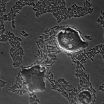(Press-News.org) Physician-researchers from the Cardiac Center at The Children's Hospital of Philadelphia (CHOP) presented new findings on pediatric cardiovascular disease at the American Heart Association's Scientific Sessions 2014 in Chicago. Among many other topics, they investigated using automated external defibrillators in infants, long-term cardiac risk in surgical survivors of the Fontan operations for congenital heart disease, and whether centers that perform more cardiac catheterizations tend to have better outcomes.
Pediatric cardiologist Yoav Dori, M.D., Ph.D., delivered a lecture on fabricating innovative 3-D models of abnormal heart structures in individual patients to assist clinicians in planning complex heart surgery for each patient. Here is his summary of this presentation:
3D Printing of Congenital Heart Disease
As the procedures performed for patients with congenital heart disease (CHD) become more complex, so does the need for better methods and tools for clinicians to understand complex three-dimensional anatomy and spatial relationships. 3-D rapid prototyping is quickly becoming a powerful tool to aid in planning, simulating, and teaching complex corrective CHD procedures. This review discusses the use of 3-D rapid prototyping in patients with CHD.
Children's Hospital clinicians also moderated scientific sessions and participated on expert panels. Below are summaries of some of the research presented at abstract sessions.
Should AEDs Be Used in Infants?
While automated external defibrillators (AEDs) have improved survival rates for out-of-hospital cardiac arrests in many patient subgroups, little is known about the safety and efficacy of AEDs in infants. Joseph Rossano, M.D., and colleagues searched the scientific literature for relevant studies of the use of external defibrillation in infants with pediatric arrhythmias. The data from clinical studies on AED use in infants are limited, with no randomized clinical trials. However, research supports the accuracy of AEDs in recognizing pediatric arrhythmias, and two case reports demonstrated the successful use of AEDs in infants. Dosage studies suggest that further research is needed to determine the most effective defibrillation doses in children. Because the available evidence suggests that AEDs are safe and effective in infants, and because survival is unlikely in the absence of prompt defibrillation, the authors recommend the use of AEDs in infants with suspected cardiac arrest.
Joseph Rossano et al, What is the Evidence for the Use of Automated External Defibrillators in Infants?
Does Volume of Cardiac Caths Correlate with Better Outcomes?
In many types of cardiology procedures, there is an association between higher institutional volume and improved outcomes. Andrew C. Glatz, M.D., and colleagues investigated whether such a relationship occurs in congenital cardiac catheterization. The study team identified all congenital cardiac catheterizations from 2011 to 2013 at 64 institutions in the IMPACT (Improving Pediatric and Adult Congenital Treatment) Registry. Of the 33,825 catheterizations, a major adverse event occurred in 711 cases (2.1%). In unadjusted analysis, the risk of adverse events was lower in centers that perform more catheterizations for congenital heart disease. However, after adjusting for patient- and procedure-level factors, there was no significant association between center volume and outcome. The researchers added that the hospital sample size and low event rate may have limited their ability to detect significant differences.
Andrew Glatz et al, Relationship between Hospital Procedure Volume and Complications Following Cardiac Catheterization: A Report from the IMPACT Registry
Fontan Survivors with PA-IVS Remain at Risk for Late Myocardial Infarction
A subset of newborns with the congenital heart condition pulmonary atresia with intact ventricular septum (PA-IVS) are at risk of myocardial infarction (MI) and sudden death because of abnormal coronary circulation. To avoid this, such patients may undergo single ventricle palliation and ultimately the Fontan procedure. Data are lacking, however, on the survivors' risk of long-term myocardial ischemia. Adam Small, M.D., Therese Giglia, M.D., and colleagues performed a retrospective review of CHOP patients who underwent the Fontan procedure for PA-IVS between 1985 and 2013. There were 46 patients who met inclusion criteria for the study, with median follow-up of 3.5 years (range 0-27.9 y) after the Fontan. There were two early deaths after Fontan. Five patients had evidence of late ischemia: 2 had non-fatal MI at 16.9 and 18.8 years post-Fontan and three additional patients had evidence of ischemia on stress test and/or cardiac MRI without clinical evidence of MI. No patient had traditional risk factors for atherosclerotic coronary disease, and there were no late deaths or sustained ventricular tachycardia. Patients with PA-IVS and single-ventricle palliation remain at risk for long-term myocardial ischemia. Further study is needed to define risk factors for ischemic outcomes.
Therese Giglia, Adam Small et al, Late Myocardial Infarction after Fontan in Pulmonary Atresia with Intact Ventricular Septum
INFORMATION:
About The Children's Hospital of Philadelphia: The Children's Hospital of Philadelphia was founded in 1855 as the nation's first pediatric hospital. Through its long-standing commitment to providing exceptional patient care, training new generations of pediatric healthcare professionals and pioneering major research initiatives, Children's Hospital has fostered many discoveries that have benefited children worldwide. Its pediatric research program is among the largest in the country. In addition, its unique family-centered care and public service programs have brought the 535-bed hospital recognition as a leading advocate for children and adolescents. For more information, visit http://www.chop.edu.
Alexandria, Va., USA - Today, the International and American Associations for Dental Research (IADR/AADR) published a special themed issue of the Journal of Dental Research (JDR) centered on novel dental biomaterials and technologies. Although the Associations have published clinical supplements to the JDR, this is the first special themed issue the Associations have published.
This special themed issue of the JDR contains a collection of timely articles designed to provide the reader with a review of some of the important new material developments, as well as examples ...
Peruvian coastal waters may provide suitable habitat that may help the recovery of endangered South Pacific green turtles, according to a study published November 19, 2014 in the open-access journal PLOS ONE by Ximena Velez-Zuazo from University of Puerto Rico and colleagues.
Green turtles inhabit tropical and subtropical coastal waters around the world. The authors of this study worked to identify suitable habitat for the endangered species by measuring two populations off the Peruvian coast from 2010 to 2013 in potentially important feeding grounds.
The researchers ...
Florida harvester ants move and construct a similar subterranean nest about once a year, according to a study published November 19, 2014 in the open-access journal PLOS ONE by Walter Tschinkel from Florida State University.
The Florida harvester ant excavates up to 2 meter deep nests in the sandy soils of the Gulf and Atlantic coastal plains. Scientists tracked and mapped nest relocations of over 400 colonies in a north Florida coastal plains pine forest from 2010 to 2013 and monitored the progress of entire relocations of 20 of these nests.
The researchers found that ...
A new study in mice, conducted by researchers at Sweden's Karolinska Institutet together with colleagues in Singapore and the United States, shows that our natural gut-residing microbes can influence the integrity of the blood-brain barrier, which protects the brain from harmful substances in the blood. According to the authors, the findings provide experimental evidence that our indigenous microbes contribute to the mechanism that closes the blood-brain barrier before birth. The results also support previous observations that gut microbiota can impact brain development ...
LA JOLLA--Scientists at the Salk Institute have discovered a powerful one-two punch for countering a common genetic mutation that often leads to drug-resistant cancers. The dual-drug therapy--with analogs already in use for other diseases--doubled the survival rate of mice with lung cancer and halted cancer in pancreatic cells.
Lung cancer, which affects nonsmokers as well as smokers, is the most common cancer worldwide, causing 1.6 million deaths a year, far more than pancreatic, breast and colon cancer combined. About 30 percent of the most common type of lung cancer ...
WASHINGTON, D.C. - An antidepressant commonly prescribed for women with postpartum depression may restore connections between cells in brain regions that are negatively affected by chronic stress during pregnancy, new research suggests.
Ohio State University scientists found that rats that had been chronically stressed during pregnancy showed depressive-like behaviors after giving birth, and structures in certain areas of their brains were less complex than in unstressed rats. After receiving the drug for three weeks, these rats had no depressive symptoms and neurons ...
New York City residents' movement around the city was perturbed, but resumed less than 24-hours after Hurricane Sandy, according to a study published November 19, 2014 in the open-access journal PLOS ONE by Qi Wang and John Taylor from Virginia Tech.
Tropical cyclones, including hurricanes and typhoons, are severe natural disasters that can cause tremendous loss of human life and suffering. Our knowledge of peoples' movements during natural disasters is so far limited due to a lack of data. The authors of this article studied human mobility using movement data from individuals ...
CORVALLIS, Ore. - Engineers have created a new way to use lidar technology to identify and classify landslides on a landscape scale, which may revolutionize the understanding of landslides in the U.S. and reveal them to be far more common and hazardous than often understood.
The new, non-subjective technology, created by researchers at Oregon State University and George Mason University, can analyze and classify the landslide risk in an area of 50 or more square miles in about 30 minutes - a task that previously might have taken an expert several weeks to months. It can ...
TALLAHASSEE, Fla. -- A new study by a Florida State University biologist shows that bleaching events brought on by rising sea temperatures are having a detrimental long-term impact on coral.
Professor Don Levitan, chair of the Department of Biological Science, writes in the latest issue of Marine Ecology Progress Series that bleaching -- a process where high water temperatures or UV light stresses the coral to the point where it loses its symbiotic algal partner that provides the coral with color -- is also affecting the long-term fertility of the coral.
"Even corals ...
New research has found that one of the world's most prolific bacteria manages to afflict humans, animals and even plants by way of a mechanism not before seen in any infectious microorganism -- a sense of touch. This unique ability helps make the bacteria Pseudomonas aeruginosa ubiquitous, but it also might leave these antibiotic-resistant organisms vulnerable to a new form of treatment.
Pseudomonas is the first pathogen found to initiate infection after merely attaching to the surface of a host, Princeton University and Dartmouth College researchers report in the journal ...






